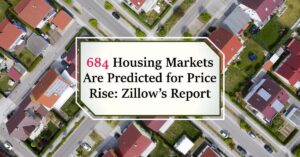While major housing markets grab headlines, hidden havens across America offer a thriving, under-the-radar housing scene. One such diamond in the rough is Rockford, Illinois. While not a name that immediately springs to mind when discussing real estate powerhouses, Rockford has stealthily ascended to claim the coveted title of America's top housing market to watch, as revealed by the annual Wall Street Journal/Realtor.com Housing Market Ranking.
The Rise of Rockford: America's Surprising No. 1 Housing Market
Nestled in the northern reaches of Illinois, Rockford's emergence as a real estate force to be reckoned with is a testament to its resilience and potential. Led by a robust economy and a myriad of recreational offerings, Rockford has captivated the attention of industry analysts and prospective homeowners alike.
The accolade bestowed upon Rockford stems from a meticulous examination of various metrics encompassing real estate demand, inventory dynamics, market velocity, and economic indicators. These criteria, ranging from median days on the market to regional price parities, collectively paint a portrait of a market brimming with promise and opportunity.
What sets Rockford apart is not merely its affordability, although this certainly plays a pivotal role. A staggering three-quarters of the top 20 markets identified boasted price tags below the national median list price, providing an enticing proposition for prospective buyers seeking value without compromise.
Rockford's ascent to preeminence underscores the Midwest's resurgence as a real estate powerhouse. With over half of the top-ranked cities hailing from the heartland, Rockford stands as a beacon of prosperity amidst a landscape teeming with potential. This regional dominance is a testament to the Midwest's enduring allure and its capacity to deliver unparalleled value to homeowners.
So, what sets Rockford apart from its counterparts? The answer lies in its unique blend of affordability, economic vitality, and strategic location. Boasting one of the lowest median home prices among its peers, Rockford beckons with an irresistible proposition for savvy buyers.
Despite its proximity to major metropolitan areas such as Chicago and Milwaukee, Rockford remains refreshingly accessible, offering a respite from the frenetic pace of urban living. This accessibility, coupled with a diverse array of employment opportunities spanning the aerospace and manufacturing sectors, underscores Rockford's appeal as a destination of choice for homebuyers seeking the best of both worlds.
However, Rockford's meteoric rise is not without its challenges. The specter of low inventory looms large, fueling heightened competition and placing upward pressure on prices. In a market where homes priced below a certain threshold elicit a flurry of offers, buyers must navigate a landscape characterized by fervent demand and limited supply.
For local real estate agents like David Dale Johnson, the surge in demand from buyers transitioning from neighboring metropolitan areas underscores Rockford's growing appeal as a haven for affordability without compromise. Despite the hurdles posed by an uptick in competition, Rockford remains steadfast in its allure, offering a sanctuary for those seeking respite from the urban sprawl.
The Top 20 Housing Markets Poised for Growth in 2024
1. Rockford, IL – Median Home List Price: $235,000
Leading the pack is Rockford, IL, a city that defies conventional expectations with its affordability and potential for growth. With a median home list price of $235,000, Rockford beckons buyers with an enticing array of properties, including a charming three-bedroom, two-bathroom house listed for just under $190,000 on Realtor.com
2. Canton, OH – Median Home List Price: $248,000
Next on the list is Canton, OH, where the median home list price stands at $248,000. This city offers a blend of affordability and opportunity, catering to a diverse range of homebuyers seeking value without compromise.
3. Ann Arbor, MI – Median Home List Price: $525,000
Ann Arbor, MI, emerges as a beacon of sophistication and style, with a median home list price of $525,000. Despite its higher price point, Ann Arbor's allure lies in its distinctive charm and diverse housing options, including a striking midcentury modern home listed for $720,000.
4. Akron, OH – Median Home List Price: $212,500
Akron, OH, offers an attractive proposition for budget-conscious buyers, with a median home list price of $212,500. This city's affordability is complemented by a robust housing market, making it an ideal destination for those seeking value and opportunity.
5. Springfield, MO – Median Home List Price: $340,000
Springfield, MO, captivates buyers with its quaint charm and affordability, boasting a median home list price of $340,000. A charming three-bedroom, two-bathroom house listed for just under $300,000 exemplifies the city's appeal to a diverse array of homebuyers.
6. Fort Wayne, IN – Median Home List Price: $325,000
Fort Wayne, IN, emerges as a hidden gem in the Midwest, with a median home list price of $325,000. Despite stiff competition for homes priced below $300,000, Fort Wayne's affordability and potential for growth make it a desirable destination for savvy homebuyers.
7. Manchester, NH – Median Home List Price: $550,000
Manchester, NH, stands as a testament to New England's enduring appeal, with a median home list price of $550,000. This city's blend of historic charm and modern amenities is epitomized by a three-bedroom, two-bathroom house listed for $375,000.
8. Columbus, OH – Median Home List Price: $380,000
Columbus, OH, offers a dynamic real estate landscape characterized by a median home list price of $380,000. This city's robust economy and diverse array of housing options make it an attractive destination for buyers seeking value and opportunity.
9. Kingsport, TN – Median Home List Price: $315,000
Kingsport, TN, captures the essence of Southern hospitality and charm, with a median home list price of $315,000. Offering a blend of affordability and scenic beauty, Kingsport beckons buyers with a four-bedroom home nestled on 2 acres.
10. Portland, ME – Median Home List Price: $623,000
Portland, ME, epitomizes coastal living at its finest, with a median home list price of $623,000. Despite its higher price point, Portland's vibrant culture and scenic vistas make it a sought-after destination for discerning homebuyers.
11. Springfield, MA – Median Home List Price: $350,000
Springfield, MA, offers a blend of affordability and charm, with a median home list price of $350,000. A cute Cape Cod listed for $325,000 exemplifies the city's appeal to buyers seeking value without compromise.
12. Burlington, VT – Median Home List Price: $499,000
Burlington, VT, captivates buyers with its picturesque landscapes and vibrant community, boasting a median home list price of $499,000. This city's blend of natural beauty and cultural attractions is underscored by a diverse housing market catering to a range of preferences.
13. Dayton, OH – Median Home List Price: $230,000
Dayton, OH, offers an attractive proposition for budget-conscious buyers, with a median home list price of $230,000. A three-bedroom brick ranch listed for $192,500 exemplifies the city's affordability and potential for growth.
14. Worcester, MA – Median Home List Price: $500,000
Worcester, MA, stands as a testament to New England's enduring appeal, with a median home list price of $500,000. This city's blend of historic charm and modern amenities is exemplified by a diverse housing market catering to a range of preferences.
15. Lancaster, PA – Median Home List Price: $420,000
Lancaster, PA, offers a picturesque backdrop for buyers seeking tranquility and charm, with a median home list price of $420,000. A four-bedroom townhouse listed for $250,000 exemplifies the city's affordability and diverse housing options.
16. Appleton, WI – Median Home List Price: $400,000
Appleton, WI, emerges as a hidden gem in the heart of Wisconsin, with a median home list price of $400,000. This city's affordability and vibrant community make it an attractive destination for buyers seeking value and opportunity.
17. Hickory, NC – Median Home List Price: $360,000
Hickory, NC, offers a blend of Southern charm and affordability, with a median home list price of $360,000. A stately home listed for $699,000 exemplifies the city's appeal to buyers seeking elegance and sophistication.
18. Toledo, OH – Median Home List Price: $230,000
Toledo, OH, captures the essence of the Midwest's affordability and charm, with a median home list price of $230,000. This city's diverse housing market and vibrant community make it an attractive destination for buyers seeking value without compromise.
19. Louisville, KY – Median Home List Price: $315,000
Louisville, KY, epitomizes Southern hospitality and charm, with a median home list price of $
315,000. A four-bedroom brick home listed for $575,000 exemplifies the city's appeal to buyers seeking elegance and sophistication.
20. Lansing, MI – Median Home List Price: $225,000
Lansing, MI, offers a blend of affordability and opportunity, with a median home list price of $225,000. This city's diverse housing market and vibrant community make it an attractive destination for buyers seeking value without compromise.
Summary: As Rockford basks in the spotlight as America's premier housing market, its ascent serves as a testament to the enduring allure of the Midwest. With affordability, economic vibrancy, and a rich tapestry of amenities at its core, Rockford stands poised to redefine the real estate landscape for years to come. For those with an eye towards the future, Rockford beckons with open arms, inviting them to partake in the journey towards homeownership in a city brimming with promise and potential.











